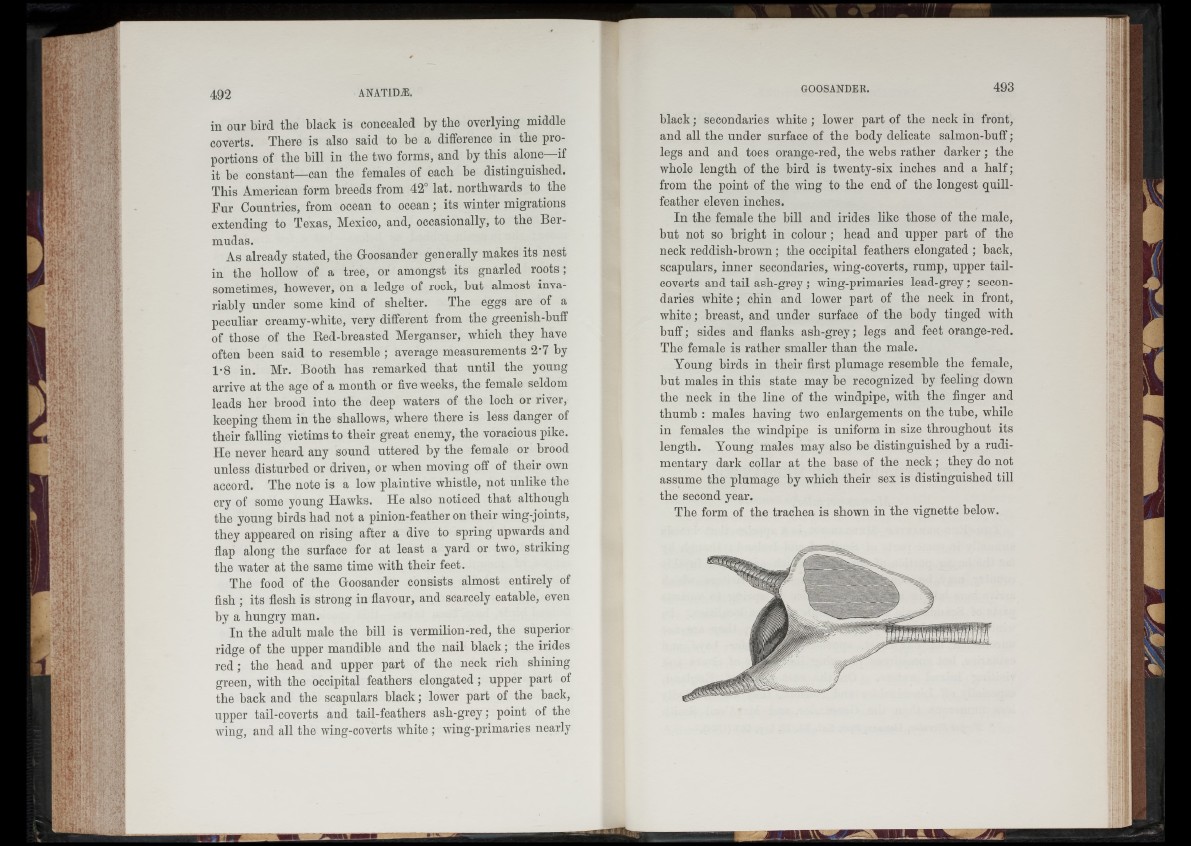
in our bird the black is concealed by the overlying middle
coverts. There is also said to be a difference in the proportions
of the bill in the two forms, and by this alone if
it be constant—can the females of each be distinguished.
This American form breeds from 42° lat. northwards to the
Fur Countries, from ocean to ocean; its winter migrations
extending to Texas, Mexico, and, occasionally, to the Bermudas.
As already stated, the Goosander generally makes its nest
in the hollow of a tree, or amongst its gnarled roots;
sometimes, however, on a ledge of rock, but almost invariably
under some kind of shelter. The eggs are of a
peculiar creamy-white, very different from the greenish-buff
of those of the Bed-breasted Merganser, which they have
often been said to resemble ; average measurements 2*7 by
1-8 in. Mr. Booth has remarked that until the young
arrive at the age of a month or five weeks, the female seldom
leads her brood into the deep waters of the loch or river,
keeping them in the shallows, where there is less danger of
their falling victims to their great enemy, the voracious pike.
He never heard any sound uttered by the female or brood
unless disturbed or driven, or when moving off of their own
accord. The note is a low plaintive whistle, not unlike the
cry of some young Hawks. He also noticed that although
the young birds had not a pinion-feather on their wing-joints,
they appeared on rising after a dive to spring upwards and
flap along the surface for at least a yard or two, striking
the water at the same time with their feet.
The food of the Goosander consists almost entirely of
fish ; its flesh is strong in flavour, and scarcely eatable, even
by a hungry man.
In the adult male the bill is vermilion-red, the superior
ridge of the upper mandible and the nail black; the irides
red; the head and upper part of the neck rich shining
green, with the occipital feathers elongated; upper part of
the back and the scapulars black; lower part of the back,
upper tail-coverts and tail-feathers ash-grey; point of the
wing, and all the wing-coverts white ; wing-primaries nearly
black; secondaries white; lower part of the neck in front,
and all the under surface of the body delicate salmon-buff;
legs and and toes orange-red, the webs rather darker ; the
whole length of the bird is twenty-six inches and a half;
from the point of the wing to the end of the longest quill-
feather eleven inches.
In the female the bill and irides like those of the male,
but not so bright in colour ; head and upper part of the
neck reddish-brown ; the occipital feathers elongated ; back,
scapulars, inner secondaries, wing-coverts, rump, upper tail-
coverts and tail ash-grey ; wing-primaries lead-grey ; secondaries
white; chin and lower part of the neck in front,
white; breast, and under surface of the body tinged with
buff; sides and flanks ash-grey; legs and feet orange-red.
The female is rather smaller than the male.
Young birds in their first plumage resemble the female,
but males in this state may be recognized by feeling down
the neck in the line of the windpipe, with the finger and
thumb : males having two enlargements on the tube, while
in females the windpipe is uniform in size throughout its
length. Young males may also be distinguished by a rudimentary
dark collar at the base of the neck ; they do not
assume the plumage by which their sex is distinguished till
the second year.
The form of the trachea is shown in the vignette below.